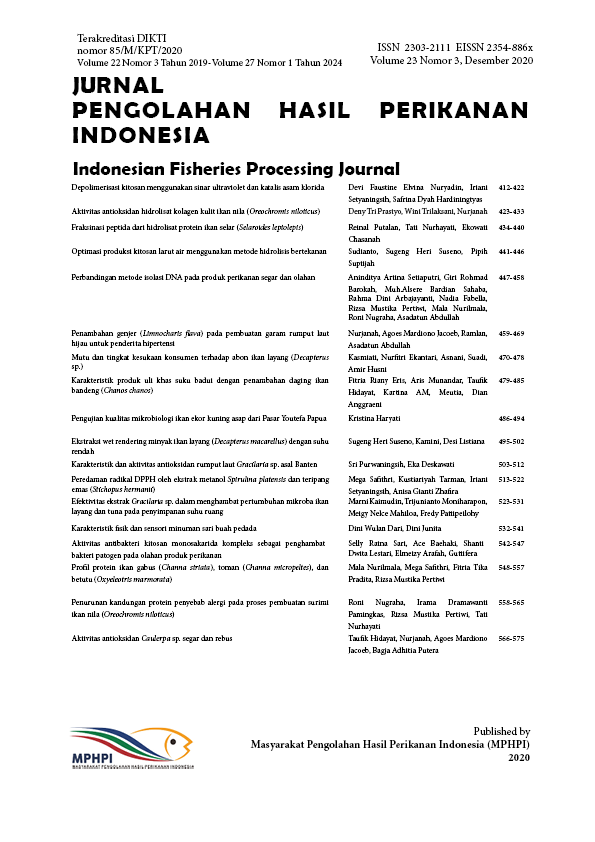Optimasi Produksi Kitosan Larut Air menggunakan Metode Hidrolisis Bertekanan Optimatization of Production Water Soluble Chitosan Using Pressurized Hidrolysis Method
Abstract
Modifications for chitosan production continue to be done so as to produce various forms of chitosan in the form of chips, granules, membranes and gels. Meanwhile, to diversify the derivatives from chitosan still needs to be done, existing chitosan diversified products such as glucosamine and water soluble chitosan production needs to be done to increase diversification and expand the use of chitosan products. The purpose of this study was to determine the optimum conditions of the water soluble chitosan production process by hydrolysis pressure using the Box-Behnken Methodology Response Surface (RSM-BoxBehnken) with Design Expert 07.0.0 program software. The RSM-Box Behnken recommends optimum conditions for production of water soluble chitosan at 1.75% HCl concentration, 1:10 ratio fo chitosan, for 45 minutes (desirability 76.1%) resulting in yield of 79,5%, pH of 5,93, water content of 25.45% , ash content of 1.33%, nitrogen level of 4.78% and solubility of chitosan of 42.66%. Processing production water soluble chitosan using the optimum conditions from the RSM recommendation obtained yield of 80%, pH of 6.0, water content of 41.9% , ash content of 1.29%, nitrogen level of 3.28% and solubility of chitosan of 66.38%.
References
Akmarina CA, Sriwidodo. 2016. Aplikasi Kitosan dalam Bidang Farmasetik. Jurnal Farmaka.14(12): .
Bija S, Yulma, Imra, Aldian, Maulana A, Rozi A. 2020. Sintesis biokoagulan berbasisi kitosan limbah sisik ikan bandeng dan aplikasinya terhadap nilai BOD dan COD limbah tahu di Kota Tarakan. Jurnal Pengolahan Hasil Perikanan Indonesia. 23(1): 86-92.
[BSN] Badan Standardisasi Nasional. 2013. SNI 7949: 2013 tentang Kitosan Syarat Mutu dan Pengolahan. Jakarta (ID): Badan Standardisasi Nasional.
Cahyono E. 2018. Karakteristik kitosan dari limbah cangkang udang windu. Jurnal Akuatika Indonesia. 3(2): 96-102.
Ibrahim B, Uju, Soleh AM. 2020. Kinerja membran komposit kitosan-karagenan pada sistem Microbial Fuel Cell dalam menghasilkan biolistrik dari limbah pemindangan ikan. Jurnal Pengolahan Hasil Perikanan Indonesia. 23 (1): 137-146.
Marieta A, Ida M. 2019. Berbagai aktivitas farmakologi dari senyawa kitosan. Jurnal Farmaka. 17 (2): 105-110.
Martins AF, Facchi SP, Folman. 2014. Antimicrobial activity of chitosan derivatives containing n-quaternized moeities in its backbone. International Journal of Molecular Sciences. 20800-20832.
Montgomery DC. 2001. Design and analysis of experimental. John Wiley & Sons Inc, New York.
Park SC, Nam JP, Kim JH, Kim YM, Nah JW, Jang MK. 2015. Antimicrobial action of water soluble β-chitosan against clinical multi-drug resistant bacteria. Journal Molecular Sciences. 16(4): 7995-8007.
Ratnawulan A, Nooe E, Suptijah P. 2018. Pemanfaatan kitosan dalam daur ulang air sebagai aplikasi teknik produksi bersih. Jurnal Pengolahan Hasil Perikanan Indonesia. 21 (2): 276-286.
Rochima E. 2014. Kajian pemanfaatan limbah rajungan dan aplikasinya untuk bahan minuman kesehatan berbasis kitosan. Jurnal Akuatika.V(1): 71-82.
Sahariah P, Gawarre VS, Lieder R. 2014. The effect of subtituent, degree of acetylation and positioning of the cationic charge on the antibacterial activity of quarternary chitosan derivatives. Journal Marine Drugs. 12 (8): 4635-4658.
Saleh CW, Harmami, Ulfin I. 2017. Pengendalian korosi menggunakan inhibitor kitosan larut air untuk baja lunak dalam media HCl 1M. Jurnal Sains dan Seni ITS. 6(1): C-1-C-4.
Selpiana, Patricia, Cindy PA. 2016. Pengaruh penambahan kitosan dan gliserol pada pembuatan bioplastik dari ampas tebu dan ampas tahu. Jurnal Teknik Kimia. 22(1): 57-64.
Sofia I, Hastami M, Norma Y. 2016. Pembuatan dan kajian sifat-sifat fisikokimia, mekanikal, dan fungsional edible film dari kitosan udang windu. Jurnal Bahan Alam Terbarukan. 5(2) 54-60.
Stevano VM, Bayu A, Isna S. 2016. Pemanfaatan kitosan dari limbah cangkang bekicot sebagai adsorben logam berat sen. Jurnal Konversi 5(1): 22-26.
Suptijah P. Ibrahim B, Ernawati. 2014. Pemanfatan limbah krustasea dalam pembuatan glukosamin hidroklorida (GlcN HCl) dengan metode autoklaf. Jurnal Teknologi Perikanan dan Kelautan. 5(2): 171-179.
Tao Y, Zhang HL, Hu YM, Wan S, Su ZQ. 2013. Preparation of chitosan and water-soluble chitosan microspheres via spray-drying method to lower blood lipids in rats with high-fat diets. International Journal of Molecular Sciences. 14(2): 4174-4184.
Authors

This work is licensed under a Creative Commons Attribution 4.0 International License.
Authors who publish with this journal agree to the following terms:
- Authors retain copyright and grant the journal right of first publication with the work simultaneously licensed under a Creative Commons Attribution License that allows others to share the work with an acknowledgement of the work's authorship and initial publication in this journal.
- Authors are able to enter into separate, additional contractual arrangements for the non-exclusive distribution of the journal's published version of the work (e.g., post it to an institutional repository or publish it in a book), with an acknowledgement of its initial publication in this journal.





